

 |
|
|
#1 | ||
|
Grizzled Veteran
Join Date: May 2006
|
From Patzer to Expert
Introduction
Regular readers of this forum will note that while I'm quite active in the weight-loss dynasty thread, my attempts at FM and tennis sim dynasties have fizzled out. The main reason for this is due to simply where I am in life personally -- I find many interesting RL challenges to simply be more compelling than the sim world. It hasn't always been this way, and perhaps later in life I will return to gaming with a passion/vengeance. As a result, at about the same time that I began improving my personal fitness(early October, about two and a half months ago), I also was looking for a new mental challenge. One of the things I have discovered is the interconnectedness of life: healthy living in each area of life(spiritual, emotional, physical, mental, etc.) promotes health and harmony in the others. Conversely, I find that ignoring one area or another leads to an unbalanced and, in my view, quite inferior life. The mental arena is the one where I haven't really 'exercised' myself in quite some time. Emotionally and spiritually I have many productive outlets -- among other things, I find expression in music, being lead vocalist for the praise team at the church I attend. Physically, my efforts to improve fitness have been quite successful so far and resulted in improved energy, focus, etc. Purpose Being less interested in the gaming world per se and wanting an outlet for my mental energies, I have returned to an old hobby with renewed vigor and a greater passion than before: chess. This is to be a chronicle of my real-life efforts in achieving my potential(whatever that may be) in the game of kings. I know there are at least a few chessplayers in these forums: I also know many others are less familiar with the game. In the last couple months I got back into the game and started working with what time I have to invest on my tactics, using mostly the Tactics Trainer at chess.com for this. I found some modest improvement, raising my rating from about 1170 to 1300 and recognizing more patterns quicker over time. Then last Tuesday, I took the plunge and played my first-ever USCF-rated event. I'll get into how that turned out in future posts, but having put in some effort on this for the last couple months and being motivated to continue it, I thought this an appropriate time to begin this dynasty here. Hopefully it will be enjoyable for those who choose to follow it, and as always with my writings I invite all comments, suggestions, and constructive criticisms. |
||
|
|

|
|
|
#2 |
|
Grizzled Veteran
Join Date: May 2006
|
Chess's Competitive Structure
I've decided to include a brief overview of the structure of competitive chess in case there are any readers who may not be aware of it, as a hopefully useful reference. Those who play will obviously know all this, but when I refer to titles and ratings and such, there may be some who don't know what I'm talking about. Elo Ratings Chess players are rated on what is known as the Elo system, named for Arpad Elo, who was among other things a professor of physics and strong chess-player in the mid-1900s. He invented the rating system which was adopted by the USCF(United States Chess Federation) in 1960, and a decade later by FIDE(the international chess-governing federation). The lower limit of the rating scale is 100, with top players approaching 3000 although there is no strict upper limit. The Elo system expects a player to win 100% of their games against players rated 400 points lower, and lose 100% against players 400 points higher, etc. Rating gains and losses are achieved by playing in sanctioned tournaments and on the basis of wins, losses, and draws -- how close a win or loss is not a factor, just the ultimate result. Up to a certain point, ratings are more volatile and change more the fewer games a player has played, changing more slowly and becoming more stable for more established players. This is particularly true for players who are provisionally rated(meaning they have less than 30 rated games). FIDE The international body, FIDE, awards three titles, none of which are of practical importance to a rank amateur such as myself, but one does occasionally run into players who have earned them at the larger events. GM = International Grand Master, the highest title. Earned by achieving norms(quality performances) against other established GMs. IM = International Master. Earned by achieving norms against other established IMs. FM = FIDE Master, given to those who maintain a 2300 or greater rating on the FIDE scale. USCF The USCF scale is similar but slightly higher than the FIDE(i.e. players tend to have a USCF rating that is 100-150 points higher than their FIDE counterpart). This is the one that I refer to if I make mention of my official chess rating. The rating scale divides into three categories: advanced, intermediate, and beginner. The advanced section would be those rated 2000 or above, as below: 2400 and up: Senior Master 2200-2399: Master 2000-2199: Expert For Masters(2200+), ratings change half as fast as for those in the lower echelons. The intermediate divisions are separated by class: 1800-1999: Class A 1600-1799: Class B 1400-1599: Class C 1200-1399: Class D 1000-1199: Class E Anybody rated below 1000 is considered a beginner or novice, or less politely using the derogatory term 'patzer' as indicated in the thread title. USCF TITLES While the rating is a mathematical calculation representing a player's relatively recent performance in tournament play, it constantly fluctuates. Titles, on the other hand, do not. A title, once earned, cannot be lost even if a player were to lose a thousand games in a row. The USCF awards the following titles: 4th Category(1200) 3rd Category(1400) 2nd Category(1600) 1st Category(1800) Candidate Master(2000) Life Master(2200) Life Senior Master(2400) A title is earned by earning five norms, i.e. quality performances, over the course of a player's career. I'll spare the statistical definition, but it is a tournament performance that would be considered impressive for the associated rating. I.e., 1600 for a 2nd Category norm, etc. Titles are more of a life achievement measurement, as opposed to a rating which measures recent tournament accomplishment. |
|
|

|
|
|
#3 |
|
Grizzled Veteran
Join Date: May 2006
|
Michigan Chess
All of my tournaments for the forseeable future will be in Michigan against mostly if not exclusively Michigan players, so I thought I'd include a bit about the current state of the game. By far the current star is FM Seth Homa, who is still fairly young(23) and has begun to have success against IMs and GMs the second half of this year. Aaron Kahn is an experienced master who has been at that level for several years, but has not progressed significantly. In the prodigy department, 15-year-old Atulya Shetty was the youngest player ever to win the Michigan Open this last year, going undefeated with five wins and two draws, and is already a solid master with a USCF rating hovering at about 2300. On a more macro scale, Michigan has somewhat fewer top players than one would expect for a state of it's size, and also a bit less than it's proportional share of chess players overall. There are a little over 1300 active in the state, out of less than 49k nationwide. So it's a slightly favorable competitive environment. |
|
|

|
|
|
#4 |
|
Grizzled Veteran
Join Date: May 2006
|
Here's my inauspicious first rated game:
Genesee County Action Quads Flint MI 12.13.2011 N. Metcalf(1489) vs. B. Swartz(Unr) 1. d4 Nf6 2. Nf3 d5 3. Bf4 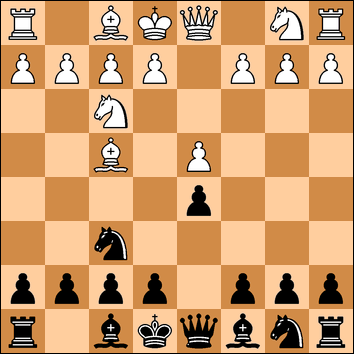 London System, which I didn't know. There are many playable options, but c5 is the most common. This gambit is most typically refused with 4. e3 Nc6 etc, the battle raging around d4. If White recaptures with dxc4, Qa5+ regains the pawn immediately, or e6 and Black has more central pawns. 3. ... Nc6 4. h3 g6 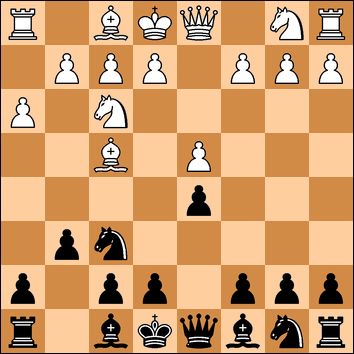 Both players committed the error of mechanical thinking in this opening. Here the bishop fianchetto really doesn't make much sense for Black. I didn't think about whether it made sense either, for some reason I had it in my mind I was playing a KID. Bf5 makes a lot more sense here, followed by e6 etc 5. e3 Bg7 6. Nbd2 Nh5? 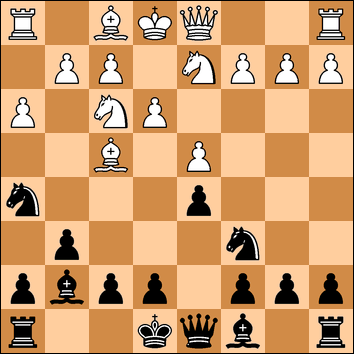 Ugh. This is very bad. After three reasonable moves to start the game, I spend two to ill-advisedly fianchetto the dark-squared bishop. Here I had no real idea what I was going to do after the bishop retreat ... since White has already played h3 I can't win the two bishops. Castling kingside is probably best, and then I can get a rook behind the e-pawn to support an advance. 7. Bh2 Bf5?? This is disastrous. In the game, neither of us saw 8. g4!, a pawn fork that wins a bishop for a pawn at best. After 8. g4! Bxg4 9. hxg4 Nf6 White is clearly in control. 8. c4 My pieces are uncoordinated, and White wisely strikes in the center while I'm not ready for battle yet. 8... e5 Played hesitantly, but the best option of those that continue to ignore the g2-g4 tactic. Taking on c4 would only help White's development and leave my opponent dominating the center. 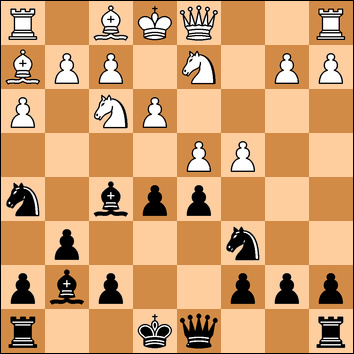 9. cxd5 Better was dxe5. This capture allows me to get my queen involved. 9... Qxd5 10. Bc4 Qa5 11. dxe5 Be6 Here I finally saw the g4 idea. Light dawns on marble head! However, putting it here instead of on d7 or the potentially risky e4(the knight is presently pinned and can't take it) allows a favorable exchange that gives me a big liability on e6. 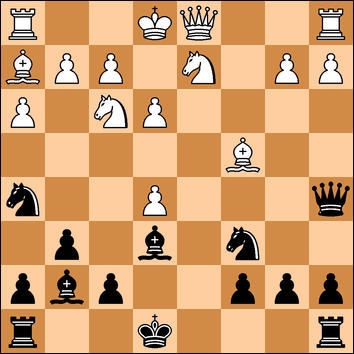 12. Bxe6 fxe6 13. O-O Getting out of the pin, but g4(trapping the knight), Qb3, or Rc1(threatening Rxc7 if the exchanges on e5 happen immediately) all could have put a lot more pressure on. 13... Nxe5 14. Nxe5 Bxe5 15. Bxe5 A critical moment. Here I made what Metcalf felt after the game was my losing move. I'm proud of it in the sense that it was a brave move, even though it loses tactically. With the obvious 15 ... Qxe5, White will naturally continue with something like 16. Nf6 or Nc4, and while I can't castle queenside right away where I'd like to be, I can bring the h5-knight back into the game and I have only a relatively small disadvantadge with even material. 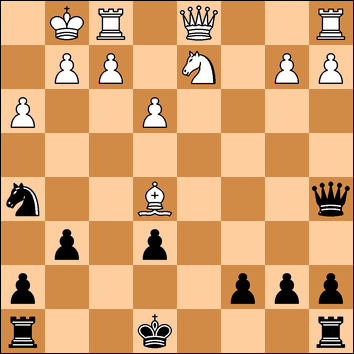 15... O-O-O The idea being to pin and win the knight and, in so doing, at least temporarily go on the attack and invade White's position. Objectively of course this is really quite bad - Bxh8(winning the exchange) is possibly better than what White played, there was also the option of Nc4 offering a queen exchange. 16. Bc3 From this point on, I know I'm busted and I the downward spiral of begins mentally. I did not fight against it hard enough. 16... Qd5 17. Nb3 Bxh8 would have been better for White. Here I had to play Rhf8 which would finally have allowed me to at least get my knight into the game. 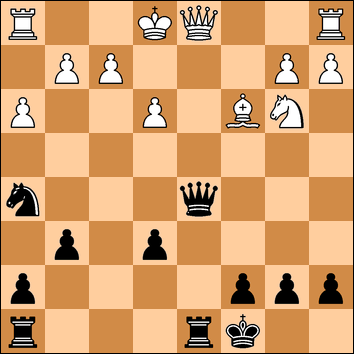 17... Qe4? 18. Qg4! Qxg4 19. hxg4 Nf6?? The knight was trapped by the queen exchange, but this loses it in the worst possible way. Ng3 would have at least damaged his pawn structure, leaving it on h5 would have allowed a temporary pawn recapture - here I simply force him to fork my rooks. 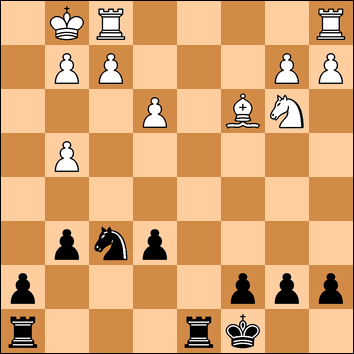 20. Bxf6 Rhf8 21. Bxd8 Rxd8 22. Rfd1 Rf8 23. Rd8+?? And here is where compassion/pity, things I have no use for in chess, though they are quite admirable in non-competitive endeavors - play your best to the end - come in. He gave a piece back intentionally to, as he put it afterwards, 'keep things interesting'. It was my first competitive game, but still. The game continued for a while longer before I resigned, but it was long past being a real contest. |
|
|

|
|
|
#5 |
|
Grizzled Veteran
Join Date: May 2006
|
Round 2
B. Swartz(Unr) v. J. Lemon(826) 1.d4 Nf6 2.c4 g6 3.Nc3 Bg7 4.Bf4?! 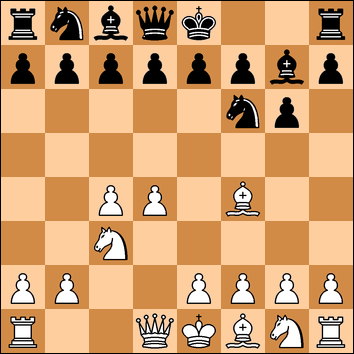 This is the point at which I wasn't really sure what to do. I'm a 1. d4 player so the KID didn't surprise me, but I always feel unsure with my bishops, not sure where they should be. My sense in looking back at the game was that this was not a particularly good placement. I took a look at some high-level games and found that Bg5 is more common, and also that e4(which I felt was a risky over-extension at the time) is the most popular idea for white. All of this is logical, since Bf4 ignores the main fight which is at the moment around d5. 4...d6 This surprised me, I would have expected d5 here. I did not think enough on the fact that Black is obviously preparing an e7-e5 push. 5. e3 O-O 6. Bd3 Re8 7. Nf3 Nc6 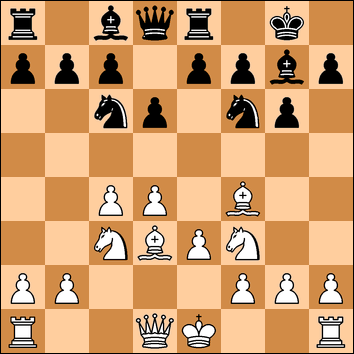 A key moment. I was concerned about 8 ... e5, which Black probably would have played if I did something passive here. After 9. dxe5 dxe5 my f4-bishop would be looking rather stupid as it has to go to g5 or retreat to g3. In either case, Black's center would be better I think. The only way I could find to stop this was to chase the c6 knight away. In retrospect, I think it would have been best to castle via 8. 0-0 e5 9. Bg5!, pinning the knight on f6 and preventing Black from benefiting from the pawn fork 9 ... e4. 8.d5 Nb4 9. Bb1 I didn't want to allow him to trade knight for bishop, and this avoids it. I didn't even think about Be2 ... However, I think I should have more seriously considered castling here as well. This looks to me to provide a more promising game in terms of initiative and solidity, i.e. 9. 0-0 Nxd3 10 Qxd3 9...e5 10.dxe6?! [i]This move is quite natural of course, but reveals a flaw that I'm seeing in my thought process over and over. When considering or even forcing an exchange, I don't adequately consider what the position will look like afterwards. The last several moves my center has been getting undermined, but the game was still even. After this trade, CMX shows Black with a clear if small edge. My king is still in the center which is opening up, the c4-pawn is under attack and looking like it may be a liability, Black has better development and initiative has clearly swung away from me. Allowing the e5 pawn to remain via 10. Bg5(or a little worse, 10. Bg3) and the g7-bishop is only a tall pawn and Black's light-squared bishop will have a much tougher time finding a home, among other plusses. 10...Bxe6 11.Qe2 Defending c4. I didn't think b3 was advisable due to how weak I'd be on the a1-h8 diagonal, things like Ng4 would be possible and the queenside looks ugly. I considered Qb3?! briefly but missed a lot of things - including that it ultimately fails due to my king still being in the center. 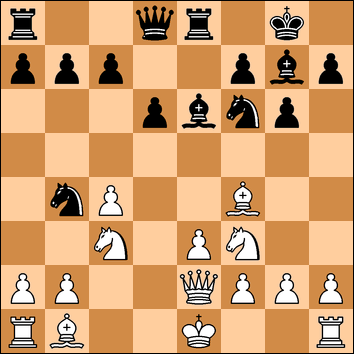 11...d5 12.a3 Nc6 13.cxd5 A trade I felt I had to make, but which helps my opponent. 13...Nxd5 14.Nxd5 Qxd5 15.O-O I felt I was in a lot of danger here and needed to get my king safe. Black's pieces are definitely better placed. 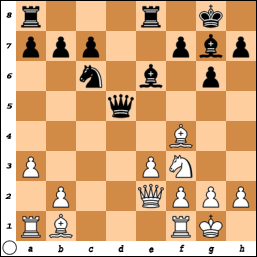 15...Qb3 Trying to attack immediately, but he missed a couple of moves in the next sequence. 16.Ba2 Qb6 Best for Black was 16 ... Qxb2 17.Qxb2 Bxb2 18.Rab1 Bxa3 19.Bxe6 Rxe6 20.Rxb7 leading to a chaotic situation with rough equality. 17.Bxe6 Rxe6 18.Rfd1 Bxb2? 19.Bxc7 My opponent didn't see this move, but both missed the superior Rab1!, which wins the bishop. 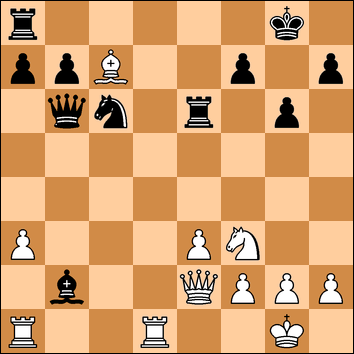 19...Qxc7 20.Qxb2 Rd8 21. Ng5 Red6 22. Rxd6 Qxd6 I, and the other players at the event, both felt I was still a little worse here. the a3 pawn is a liability, Black's probably got a superior endgame. Concerned about Ne5, I played my next move knowing it was probably bad but unable to think of anything better. 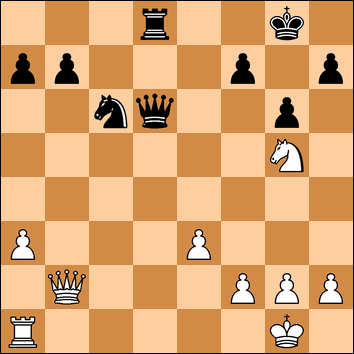 Completely on accident, my next move also stops the threat I totally did not see: 23 ... Qd1+! 24. Rxd1 Rxd1#. 23. f4?! h6 24. Ne4 Qe7?? This move objectively loses the game. I never saw it though, even in looking through the moves afterwards, until my computer showed me the line. 24 ... Qe6 was more accurate. 25. Nf6+ Kf8 26. Nh7+? This eventually forces a draw by repetition, but misses the winning sequence of 26 Nd5!! when Black cannot defend against the dual threats of Nxe7 and Qh8 checkmate. White will have a queen for a knight at worst - a winning material advantadge. 26...Ke8 27. Nf6+ Kf8 28. Nh7+ Ke8 29. Nf6+ Kf8 Draw by three-fold repetition agreed, the first such ending to a game I've ever played. 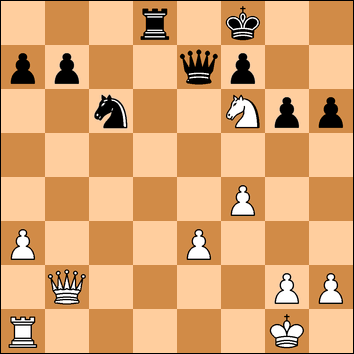 |
|
|

|
|
|
#6 |
|
Coordinator
Join Date: Jan 2002
Location: Hog Country
|
Hey! Cool. I did one of these a while back and then moved it off-site to a blog. I will be following along. I might take a close look at your games and make some comments if I get the chance.
|
|
|

|
|
|
#7 |
|
Grizzled Veteran
Join Date: May 2006
|
Thanks! If you do decide to chime in I'm sure it will be helpful, as I read parts of yours and you're a better player than I.
|
|
|

|
|
|
#8 |
|
Grizzled Veteran
Join Date: Nov 2000
Location: St. Paul, MN
|
In game 1, how about 17...Qxg2. You're threatening QxR and RxQ and no move I can see parries both.
|
|
|

|
|
|
#9 |
|
Grizzled Veteran
Join Date: May 2006
|
That's a diagram error by me, unfortunately. I'll try to be more careful with those.
White's already castled there as the previous diagram shows. Thanks though  . . |
|
|

|
|
|
#10 |
|
Grizzled Veteran
Join Date: May 2006
|
I meant to post my final-round game some while back, and never got around to it.
Round 3 B. Swartz(Unr) v. M. Aldrich(141) My opponent was the TD's son, 8 or 9 I think. It's interesting playing a game which would be embarrassing to not win, it definitely makes it a challenge to try to be calm and simply play the best moves. 1. d4 d5 2. c4 Be6 The first opportunity - blocking the e-pawn like this is asking for trouble and I knew I should find a way to punish this. 3. cxd5 Bxd5 4. Nc3 e6 5. e4 Bc6 6. Be3 This is the first move that I'm not really sure about. Up to this point, I've done reasonably well I think in taking advantadge of Black's mistakes and establishing a superior position based on central control. d5 looks tempting but intuitively wrong here, but I think I should have looked at it more. 6. d5 cxd5 7. exd5 Bd7 looks strong. 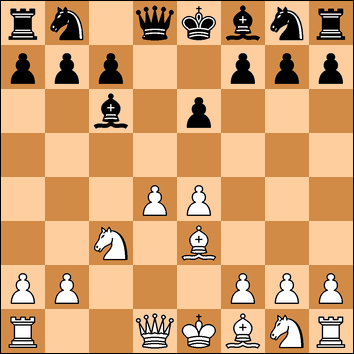 6. ... Bb4 7. a3 Bd6 8. d5 Bd7 9. Bb5 c6 10. dxc6 bxc6 11. Ba4 Nf6 12. Qxd6 I don't think I attacked all that accurately up to this point, but the defense was error-ridden and now I'm up a bishop with a lot more activity and Black's in a ton of trouble. 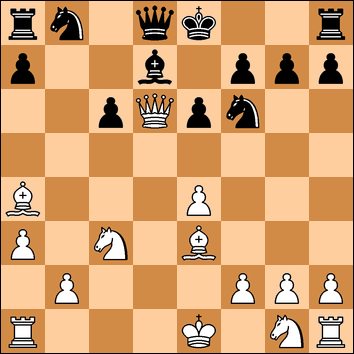 12. ... Ng4 13. Bc5 Na6 14. Bd4 Bxc6 would have been more to the point here, continuing to destroy Black's defenses. 14 ... Qa5 15. Bxc6 Bxc6 16. Qxc6+ Ke7 17. Qb7+ I would have been better off castling here, unpinning my knight and getting another piece into the attack. If 17 ... Qc7, 18. Qb3 Rab8 19. Qc2 and Black has stopped my initiative for the time being. 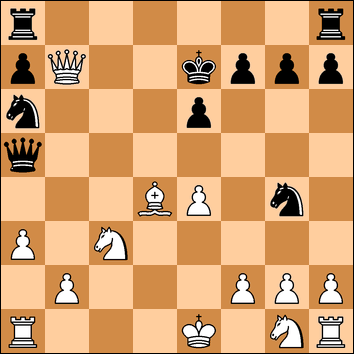 17. ... Ke8?? 18. Qxa8+ Kd7?? 19. Qxh8 Nb4! A very good move which threatens two things: if I take the knight, my rook goes to the queen and the b2 pawn will fall next. If I don't, 20 ... Nc7+ looms as a powerful triple fork. But I have an excellent answer for this. 20. 0-0-0 Nd3+? 21. Rxd3 Nxf2? 22. Bb6+ Wow. Just wow, here. I saw the double threat(check and attack on the queen) and didn't bother to consider all the ramifications. When I'm prohibitively ahead like this, I often get the disease of 'threat blindness', and this is is so absurdly obvious. With the correct and obvious 22 ... Nxd3+ 23. Kc2 Qxb6 24. Kxd3 black turns the tables a bit and a lot of unnecessary complication results. This is the kind of error that needs to get mercilessly removed from my thought process. 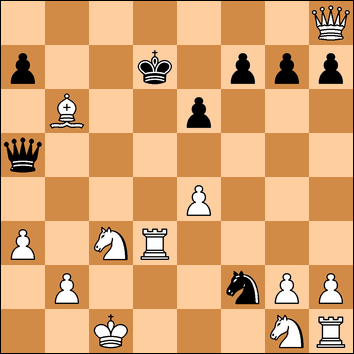 22 ... Kc6?? 23. Qc8+ Drunk as I was with finishing the game off, I thought this was mate, hanging a piece for no good reason for the second straight move. As it ends up it doesn't matter, there wasn't a faster way to mate and I think this is actually the right move. But the fact that I didn't see the bishop hanging here is pretty darn inexcusable. 23. ... Kxd6 24. Rd6# 1-0 Last edited by Brian Swartz : 01-11-2012 at 12:25 PM. |
|
|

|
|
|
#11 |
|
Grizzled Veteran
Join Date: May 2006
|
1 win, 1 draw, and 1 loss for my first event. Something for everyone, and I came out of it with an initial provisional rating of 887.
My next event is my first sizable one, the Michigan Class Championships this weekend. A surprising bit of good fortune in that the TD is allowing me to play up into the 'E' section -- meaning I'll be going up against players mostly in the 950-1150 range. I had thought I would be required to play in the Novice(U1000) section. Playing up whenever possible is definitely my strategy, as you learn more from losses than wins in general. Aside from being the best way to improve, it also affords greater rating rewards if I do well. It's entirely possible I'll get my brain beat in as well of course. This is also a longer time control event, 3 4-hour games on Saturday which is standard for larger tournaments, and 2 5-hour games on Sunday. The mental toughness part of the game will really come into play here -- it can be very difficult and frustrating to try to keep playing well in complicated/inferior positions in a long struggle. I'm not sure how I'll react to that. I've continued working with the Tactics Trainer at chess.com -- the three games already mentioned here showed that tactics are even more important to my improvement than I thought they were, so that's my primary emphasis -- and my success rate has increased from about 53 to 65% in recent weeks, as well as increasing my rating somewhat to a max of 1480, about 1350 on average. This weekend will definitely give me a better idea of where I'm at and what I need to improve most. The next big tournament is the tournament as far as Michigan chess is concerned, the Great Lakes Open in May. So I'll be using what happens the next few days as a guide to my study in the intervening months. Last edited by Brian Swartz : 01-12-2012 at 08:53 AM. |
|
|

|
|
|
#12 | ||||||
|
Grizzled Veteran
Join Date: Nov 2000
Location: St. Paul, MN
|
Quote:
I'm not so sure about d5 just yet. You get to kick his bishop and mess up his queenside development so it's good in the short run for sure, but long-term you're also isolating your d pawn and his bishop will eventually get a decent post on f5 or g4. In a position like this, you don't want to be too hasty about advancing your central pawns. Keeping them at d4-e4 deprives the opponent of space and controls a good bit of squares. Only after you develop around them and protect the squares that would be weak after they move do you look for a breakthrough. This hangs a pawn to 7...BxN+ 8. bxc3 Bxe4. 7. Bd3 handles that threat and brings out another piece. If 7...Nf6, then 8.Qc2 protects e4 again and he has nothing further to throw at it. Still too eager to advance before you're ready. I prefer 8. Nf3 adding influence to your central dark squares and getting a step closer to castling. Not a fan of this move either. I think the past few moves based on your commentary and your moves, you rightfully saw your opponent's position as dubious and wanted to immediately punish him, but when you have a spatial advantage, you mostly want to protect the center and prevent him from playing freeing moves. Other than that, you want to maintain the status quo and avoid exchanges if possible (because with less space, it will be harder for him to find good squares for his pieces the more pieces he has left). Here his Bd7 and your d5 pawn interfere with his knight going to the most natural posts at c6 and d7, but after Bb5, he can trade off the poor d7 bishop and play his knight to d7, which eventually can go to c5 or e5 (the squares weakened by advancing d4-d5). [/quote] Quote:
Black is busted, down a piece, his dark squares are a mess, and he can't castle without offering an exchange of queens (which you could still prevent with 12...Qe7 13.Bc5). He probably needs to play Ng4-f6-Kf7 though that loosens his position further. In a position where you have an overwhelming advantage, the primary consideration is to not allow your opponent any counterplay. Make sure your king is safe, don't play risky moves, make sure all your pieces are in play, trade off dangerous opposing pieces, etc... Quote:
Yes, the tactics work for you after 14. Bxc6 Rc8 15. Qxd7+ Qxd7 16. Bxd7+ Kxd7 17. Bd4. Quote:
Missed an opportunity to pick up another piece immediately after 17. b4: a. 17...Nxb4 18. Qb7+ and 19. Qxb4. b. 17...Qg5 18. Qxa6 c. 17...Rb8 18. Qxb8 followed by retreating your queen or capturing his. However, he probably has to lose a piece here anyway. If 17...Kd6 then 18. Nb5+ wins the queen and after 17...Nc7 18. b4 still forces the win of at least the knight. Quote:
Can't really argue about picking up another free rook, but it does put your queen out of play a bit. At this point you could've considered giving back a bit of material to get rid of one of his remaining pieces with 20.axb4 QxR+ 21. Nd1, followed by Nf3-0-0-and getting your queen and knight back into play where Black can't do anything. But hey, a lot of things are right when you're up 2 rooks and a bishop. Quote:
Nicely done. Good luck this weekend, looking forward to seeing your games. Last edited by JAG : 01-13-2012 at 12:44 PM. |
||||||
|
|

|
 |
| Currently Active Users Viewing This Thread: 1 (0 members and 1 guests) | |
| Thread Tools | |
|
|